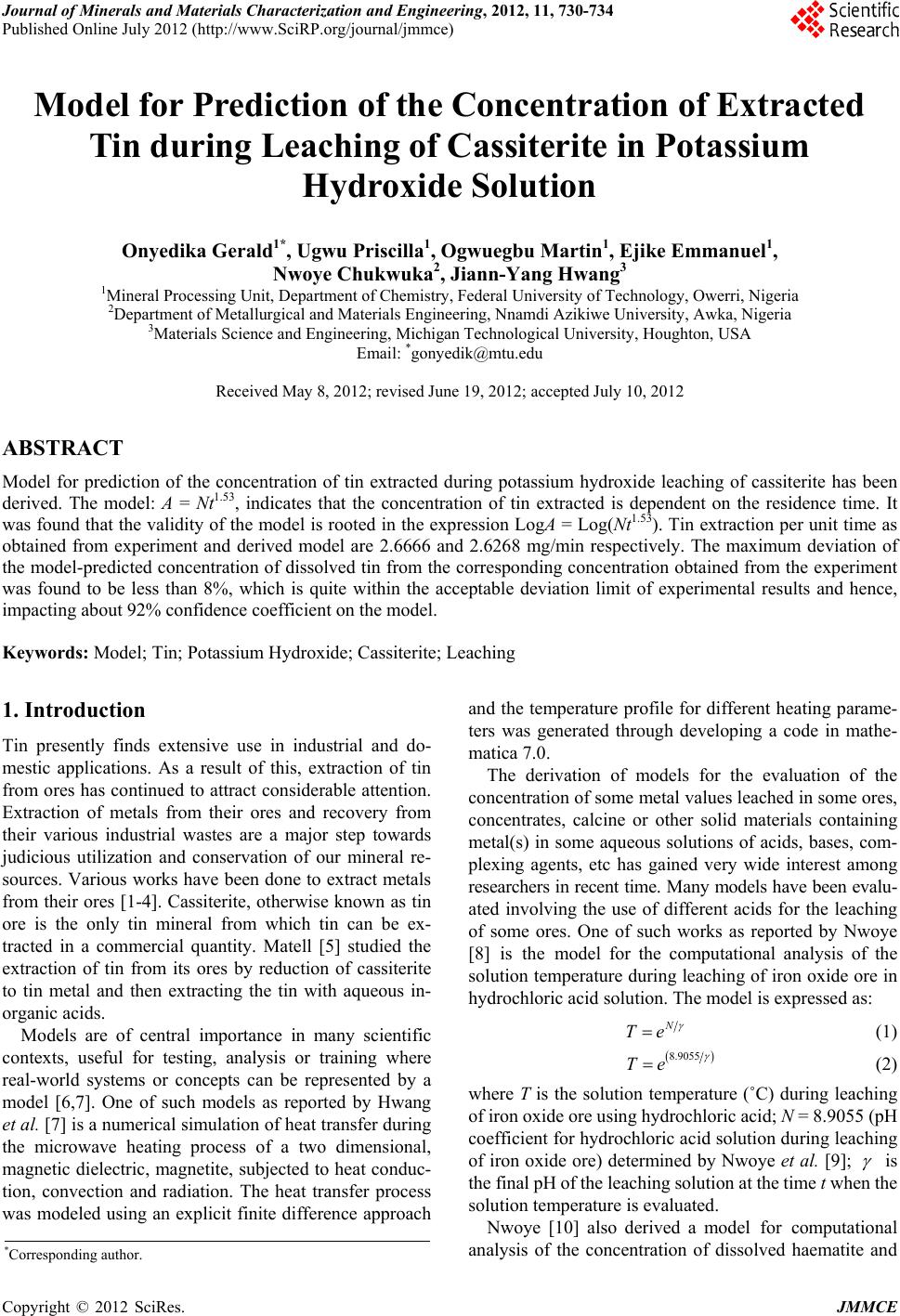
Journal of Minerals and Materials Characterization and Engineering, 2012, 11, 730-734
Published Online July 2012 (http://www.SciRP.org/journal/jmmce)
Model for Prediction of the Concentration of Extracted
Tin during Leaching of Cassiterite in Potassium
Hydroxide Solution
Onyedika Gerald1*, Ugwu Priscilla1, Ogwuegbu Martin1, Ejike Emmanuel1,
Nwoye Chukwuka2, Jiann-Yang Hwang3
1Mineral Processing Unit, Department of Chemistry, Federal University of Technology, Owerri, Nigeria
2Department of Metallurgical and Materials Engineering, Nnamdi Azikiwe University, Awka, Nigeria
3Materials Science and Engineering, Michigan Technological University, Houghton, USA
Email: *gonyedik@mtu.edu
Received May 8, 2012; revised June 19, 2012; accepted July 10, 2012
ABSTRACT
Model for prediction of the concentration of tin extracted during potassium hydroxide leaching of cassiterite has been
derived. The model: A = Nt1.53, indicates that the concentration of tin extracted is dependent on the residence time. It
was found that the validity of the model is rooted in the expression LogA = Log(Nt1.53). Tin extraction per unit time as
obtained from experiment and derived model are 2.6666 and 2.6268 mg/min respectively. The maximum deviation of
the model-predicted concentration of dissolved tin from the corresponding concentration obtained from the experiment
was found to be less than 8%, which is quite within the acceptable deviation limit of experimental results and hence,
impacting about 92% confidence coefficient on the model.
Keywords: Model; Tin; Potassium Hydroxide; Cassiterite; Leaching
1. Introduction
Tin presently finds extensive use in industrial and do-
mestic applications. As a result of this, extraction of tin
from ores has continued to attract considerable attention.
Extraction of metals from their ores and recovery from
their various industrial wastes are a major step towards
judicious utilization and conservation of our mineral re-
sources. Various works have been done to extract metals
from their ores [1-4]. Cassiterite, otherwise known as tin
ore is the only tin mineral from which tin can be ex-
tracted in a commercial quantity. Matell [5] studied the
extraction of tin from its ores by reduction of cassiterite
to tin metal and then extracting the tin with aqueous in-
organic acids.
Models are of central importance in many scientific
contexts, useful for testing, analysis or training where
real-world systems or concepts can be represented by a
model [6,7]. One of such models as reported by Hwang
et al. [7] is a numerical simulation of heat transfer during
the microwave heating process of a two dimensional,
magnetic dielectric, magnetite, subjected to heat conduc-
tion, convection and radiation. The heat transfer process
was modeled using an explicit finite difference approach
and the temperature profile for different heating parame-
ters was generated through developing a code in mathe-
matica 7.0.
The derivation of models for the evaluation of the
concentration of some metal values leached in some ores,
concentrates, calcine or other solid materials containing
metal(s) in some aqueous solutions of acids, bases, com-
plexing agents, etc has gained very wide interest among
researchers in recent time. Many models have been evalu-
ated involving the use of different acids for the leaching
of some ores. One of such works as reported by Nwoye
[8] is the model for the computational analysis of the
solution temperature during leaching of iron oxide ore in
hydrochloric acid solution. The model is expressed as:
N
Te
(1)
8.9055
Te
(2)
where T is the solution temperature (˚C) during leaching
of iron oxide ore using hydrochloric acid; N = 8.9055 (pH
coefficient for hydrochloric acid solution during leaching
of iron oxide ore) determined by Nwoye et al. [9];
is
the final pH of the leaching solution at the time t when the
solution temperature is evaluated.
Nwoye [10] also derived a model for computational
analysis of the concentration of dissolved haematite and
*Corresponding author.
Copyright © 2012 SciRes. JMMCE